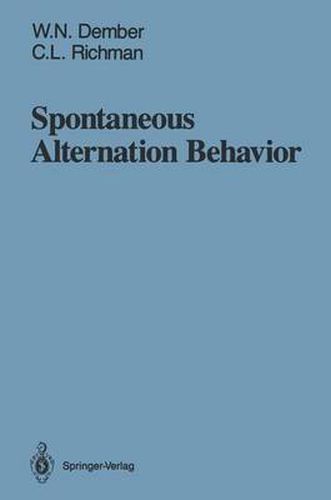Readings Newsletter
Become a Readings Member to make your shopping experience even easier.
Sign in or sign up for free!
You’re not far away from qualifying for FREE standard shipping within Australia
You’ve qualified for FREE standard shipping within Australia
The cart is loading…






This title is printed to order. This book may have been self-published. If so, we cannot guarantee the quality of the content. In the main most books will have gone through the editing process however some may not. We therefore suggest that you be aware of this before ordering this book. If in doubt check either the author or publisher’s details as we are unable to accept any returns unless they are faulty. Please contact us if you have any questions.
A wide variety of species, including human beings, exhibits a remarkably reliable behavior pattern, known as spontaneous alternation behavior (SAB), that has intrigued researchers for over seven decades. Though the details may vary depending on species and setting, SAB essentially entails first choosing one member of a pair of alternatives and then the other, without instructions or incen tives to do so. Spontaneous alternation is manifested even in the early trials of a discrimination-learning experiment, where only one of the choices is reinforced. Indeed, that was the setting in which SAB was first noted (Hunter, 1914). Rein forcement contingencies, evidently, are superimposed, not on a random sequence of choices, but on a potent, systematic behavior pattern. This book is the first to be devoted entirely to SAB and closely related phenomena, such as habituation and exploration. The literature on SAB is vast, covering a host of questions ranging from the cues that guide alternation to its phylogenetic and ontogenetic generality, its relation to learning and motivation, and its neurochemical substrates. In separate chapters we take up each of the major issues, reviewing what is known about the several facets of SAB and revealing areas of ignorance. The chapter authors were encouraged to discuss their own research where pertinent, some of it as yet unpublished, indeed some conducted specifically for this volume.
$9.00 standard shipping within Australia
FREE standard shipping within Australia for orders over $100.00
Express & International shipping calculated at checkout
This title is printed to order. This book may have been self-published. If so, we cannot guarantee the quality of the content. In the main most books will have gone through the editing process however some may not. We therefore suggest that you be aware of this before ordering this book. If in doubt check either the author or publisher’s details as we are unable to accept any returns unless they are faulty. Please contact us if you have any questions.
A wide variety of species, including human beings, exhibits a remarkably reliable behavior pattern, known as spontaneous alternation behavior (SAB), that has intrigued researchers for over seven decades. Though the details may vary depending on species and setting, SAB essentially entails first choosing one member of a pair of alternatives and then the other, without instructions or incen tives to do so. Spontaneous alternation is manifested even in the early trials of a discrimination-learning experiment, where only one of the choices is reinforced. Indeed, that was the setting in which SAB was first noted (Hunter, 1914). Rein forcement contingencies, evidently, are superimposed, not on a random sequence of choices, but on a potent, systematic behavior pattern. This book is the first to be devoted entirely to SAB and closely related phenomena, such as habituation and exploration. The literature on SAB is vast, covering a host of questions ranging from the cues that guide alternation to its phylogenetic and ontogenetic generality, its relation to learning and motivation, and its neurochemical substrates. In separate chapters we take up each of the major issues, reviewing what is known about the several facets of SAB and revealing areas of ignorance. The chapter authors were encouraged to discuss their own research where pertinent, some of it as yet unpublished, indeed some conducted specifically for this volume.